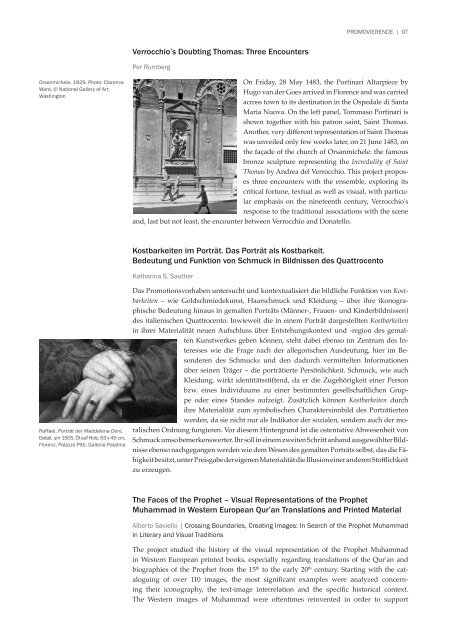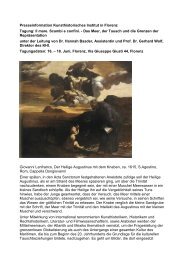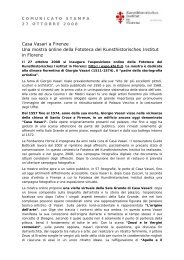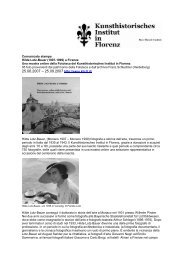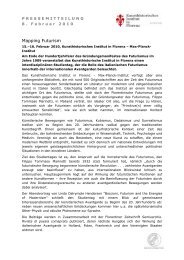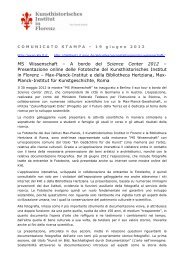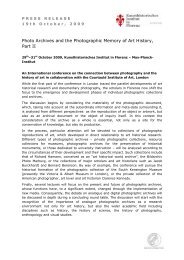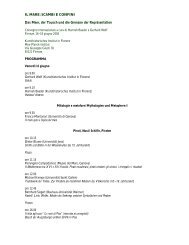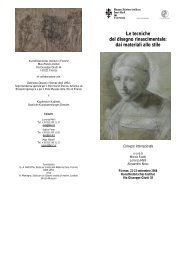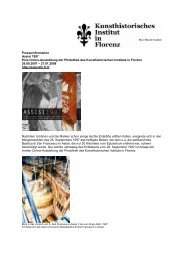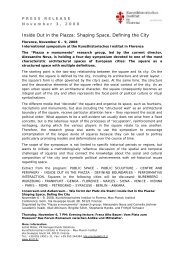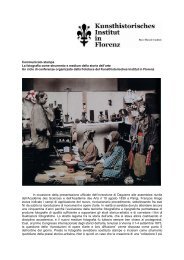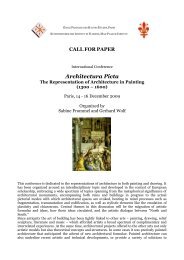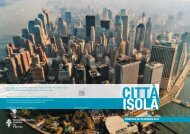forschungsbericht november 2008 – juli 2012 - Kunsthistorisches ...
forschungsbericht november 2008 – juli 2012 - Kunsthistorisches ...
forschungsbericht november 2008 – juli 2012 - Kunsthistorisches ...
Erfolgreiche ePaper selbst erstellen
Machen Sie aus Ihren PDF Publikationen ein blätterbares Flipbook mit unserer einzigartigen Google optimierten e-Paper Software.
PROMOVIERENDE | 97<br />
Verrocchio’s Doubting Thomas: Three Encounters<br />
Per Rumberg<br />
Orsanmichele, 1929, Photo: Clarence<br />
Ward, © National Gallery of Art,<br />
Washington<br />
On Friday, 28 May 1483, the Portinari Altarpiece by<br />
Hugo van der Goes arrived in Florence and was carried<br />
across town to its destination in the Ospedale di Santa<br />
Maria Nuova. On the left panel, Tommaso Portinari is<br />
shown together with his patron saint, Saint Thomas.<br />
Another, very different representation of Saint Thomas<br />
was unveiled only few weeks later, on 21 June 1483, on<br />
the façade of the church of Orsanmichele: the famous<br />
bronze sculpture representing the Incredulity of Saint<br />
Thomas by Andrea del Verrocchio. This project proposes<br />
three encounters with the ensemble, exploring its<br />
critical fortune, textual as well as visual, with particular<br />
emphasis on the nineteenth century, Verrocchio's<br />
response to the traditional associations with the scene<br />
and, last but not least, the encounter between Verrocchio and Donatello.<br />
Kostbarkeiten im Porträt. Das Porträt als Kostbarkeit.<br />
Bedeutung und Funktion von Schmuck in Bildnissen des Quattrocento<br />
Katharina S. Sauther<br />
Raffael, Porträt der Maddalena Doni,<br />
Detail, um 1505, Öl auf Holz, 63 x 45 cm,<br />
Florenz, Palazzo Pitti, Galleria Palatina<br />
Das Promotionsvorhaben untersucht und kontextualisiert die bildliche Funktion von Kostbarkeiten<br />
<strong>–</strong> wie Goldschmiedekunst, Haarschmuck und Kleidung <strong>–</strong> über ihre ikonographische<br />
Bedeutung hinaus in gemalten Porträts (Männer-, Frauen- und Kinderbildnissen)<br />
des italienischen Quattrocento. Inwieweit die in einem Porträt dargestellten Kostbarkeiten<br />
in ihrer Materialität neuen Aufschluss über Entstehungskontext und -region des gemalten<br />
Kunstwerkes geben können, steht dabei ebenso im Zentrum des Interesses<br />
wie die Frage nach der allegorischen Ausdeutung, hier im Besonderen<br />
des Schmucks und den dadurch vermittelten Informationen<br />
über seinen Träger <strong>–</strong> die porträtierte Persönlichkeit. Schmuck, wie auch<br />
Kleidung, wirkt identitätsstiftend, da er die Zugehörigkeit einer Person<br />
bzw. eines Individuums zu einer bestimmten gesellschaftlichen Gruppe<br />
oder eines Standes aufzeigt. Zusätzlich können Kostbarkeiten durch<br />
ihre Materialität zum symbolischen Charaktersinnbild des Porträtierten<br />
werden, da sie nicht nur als Indikator der sozialen, sondern auch der moralischen<br />
Ordnung fungieren. Vor diesem Hintergrund ist die ostentative Abwesenheit von<br />
Schmuck umso bemerkenswerter. Ihr soll in einem zweiten Schritt anhand ausgewählter Bildnisse<br />
ebenso nachgegangen werden wie dem Wesen des gemalten Porträts selbst, das die Fähigkeit<br />
besitzt, unter Preisgabe der eigenen Materialität die Illusion einer anderen Stofflichkeit<br />
zu erzeugen.<br />
The Faces of the Prophet <strong>–</strong> Visual Representations of the Prophet<br />
Muhammad in Western European Qur’an Translations and Printed Material<br />
Alberto Saviello | Crossing Boundaries, Creating Images: In Search of the Prophet Muhammad<br />
in Literary and Visual Traditions<br />
The project studied the history of the visual representation of the Prophet Muhammad<br />
in Western European printed books, especially regarding translations of the Qur'an and<br />
biographies of the Prophet from the 15 th to the early 20 th century. Starting with the cataloguing<br />
of over 110 images, the most significant examples were analyzed concerning<br />
their iconography, the text-image interrelation and the specific historical context.<br />
The Western images of Muhammad were oftentimes reinvented in order to support


